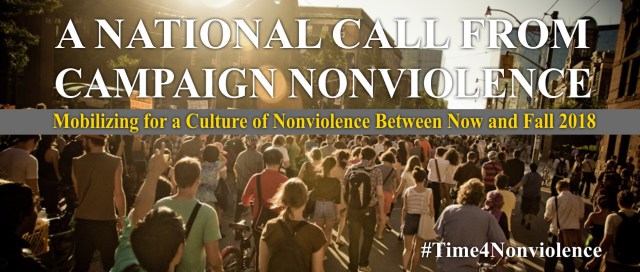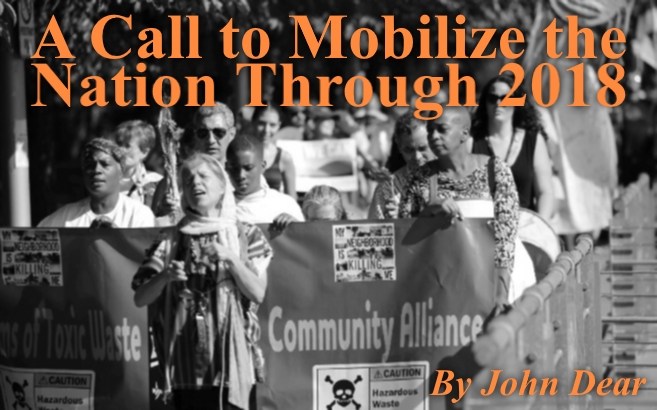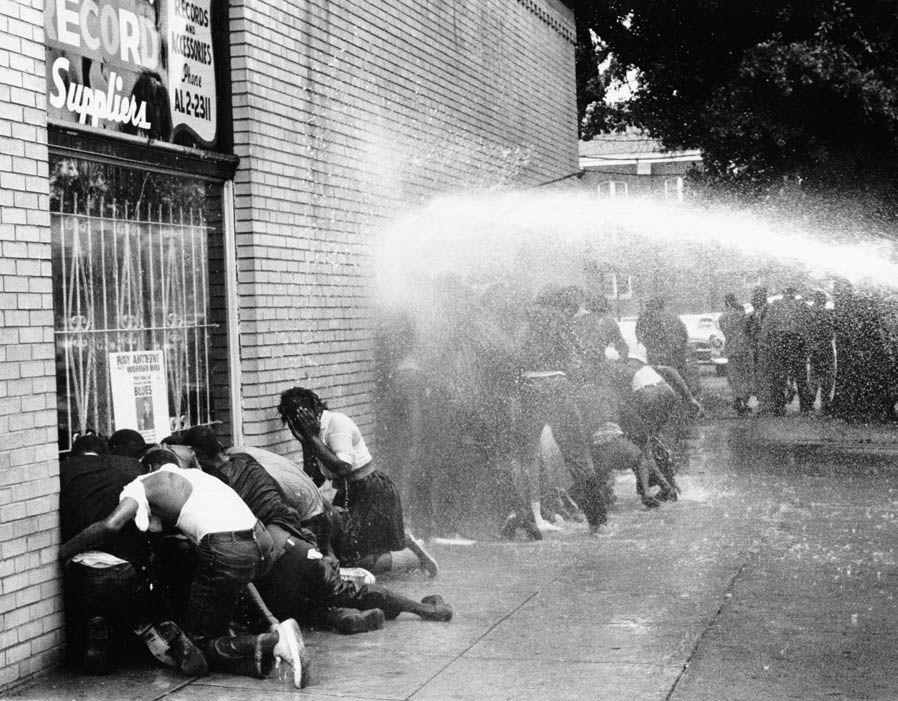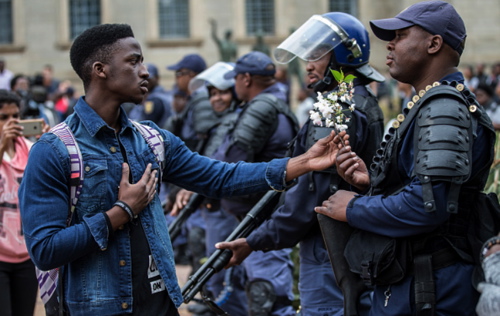by Benjamin Naimark-Rowse

The Stamp Act repeal depicted as a 1765 funeral procession; courtesy commons.wikimedia.org
On the Fourth of July, cities and towns from coast-to-coast across the United States host fireworks, concerts, and parades to celebrate our independence from Britain. Those celebrations will invariably highlight the colonial soldiers who overcame the British. But the lessons we learn of a democracy forged in the crucible of revolutionary war tends to ignore how a decade of nonviolent resistance before the shot-heard-round-the-world (1) shaped the founding of the United States, strengthened our sense of political identity, and laid the foundation of our democracy.
Read the rest of this article »
by Pace e Bene

Banner illustration courtesy paceebene.org
Editor’s Preface: Pace e Bene is the organizer of Campaign Nonviolence (CNV). We post here their call to mobilize as another in our series of statements of purpose by nonviolent organizations. CNV aims to build a broad coalition united in its efforts to hold the Trump administration accountable through nonviolent action and protest. Please note that we have also posted a series of articles tracing the history of US nonviolence to its roots in Quaker, pre-Revolution Pennsylvania. CNV can, therefore, be seen in an historical context as a quintessentially American movement. Above all, the Campaign demonstrates how vibrant and hopeful nonviolent resistance is today in a divided America. JG
The Call for a Culture of Nonviolence
In the face of the Trump Administration’s priorities—demonizing immigrants, dismantling social programs, destroying environmental safeguards, diminishing civil rights, and dramatically increasing the prospect of war—we call on you, and your loved ones, and your friends—and all people everywhere—to be part of an unprecedented movement-of-movements for a culture of nonviolence free from war, poverty, racism and environmental catastrophe.
Read the rest of this article »
by John Dear

Banner illustration courtesy paceebene.org
While the media and the nation sit transfixed over the Trump scandals and attacks on democracy, those of us who work for justice and peace know that we have to keep working, resisting, and mobilizing people across the country if we are going to have the social, economic and political transformation we need for our survival.
In other words, we’ve only just begun. Instead of giving up, giving in, or throwing in the towel, instead of sitting glued to the tube, we’re going forward. The campaign for a new culture of nonviolence is on!
Read the rest of this article »
by Brandon Jacobsen

African American children attacked by police in Birmingham, AL; May 3, 1963; courtesy wagingnonviolence.org
The anti-Trump resistance movement has been effective in its nascent stage, utilizing public protests to signal opposition to the president’s plans. In taking to the streets, airports and congressional town hall meetings, the resistance has had a decisive impact on blocking the discriminatory travel ban on individuals from Muslim-majority countries, and on rendering the first iteration of the Republican health care replacement plan dead in the water.
Read the rest of this article »
by Gene Sharp

Dustwrapper art courtesy aeinstein.org
What nonviolent action is.
Nonviolent action is a technique of sociopolitical action for applying power in a conflict without the use of physical violence. Nonviolent action may involve acts of omission—that is, people may refuse to perform acts that they usually perform, are expected by custom to perform, or are required by law or regulation to perform; acts of commission—that is, people may perform acts that they do not usually perform, are not expected by custom to perform, or are forbidden to perform; or a combination of the two.
As a technique nonviolent action is not passive.
It is not inaction. It is action that is nonviolent.
As a technique, therefore, nonviolent action is not passive. It is not inaction. It is action that is nonviolent. These acts comprise a multitude of specific methods of action or “nonviolent weapons.”
Nearly two hundred have been identified to date, and without doubt, scores more already exist or will emerge in future conflicts. Three broad classes of nonviolent methods exist: nonviolent protest and persuasion, non-cooperation, and nonviolent intervention.
Nonviolent action provides a way to wield power in order to achieve objectives and to sanction opponents without the use of physical violence.
Read the rest of this article »
by Kazu Haga

South African student presenting flowers to police; courtesy gettyimages.com
“Bernard? Oh yeah, he’s great. He was always the principles guy.” That was what an old Student Nonviolent Coordinating Committee (SNCC) organizer told me when I mentioned that I had been trained by Bernard Lafayette, co-author of the Kingian Nonviolence curriculum and a legend of the civil rights era. “I was always a strategies guy,” this elder went on to tell me. “I believed in nonviolence as an effective strategy, but Bernard was always talking about nonviolence as a principle.”
Read the rest of this article »
by War Resisters League

Dustwrapper art courtesy www.warresisters.org
Refusing to pay taxes for war is probably as old as the first taxes levied for warfare. We offer below a summary of such protest, which is to say it does not include other forms of tax refusal and resistance, a common tactic in worldwide labor movements, for example, or in various anti-colonial protests including such well-known examples as the Boston Tea Party.
Indeed, until World War II, war tax resistance in the U.S. manifested itself primarily among members of the historic peace churches — Quakers, Mennonites, and Brethren — and usually only during times of war. There have been instances of people refusing to pay taxes for war in virtually every American war, but it was not until World War II and the establishment of a permanent, centralized U.S. military (symbolized by the building of the Pentagon) that the modern war tax resistance movement was born.
Colonial America
One of the earliest known instances of war tax refusal took place in 1637 when the relatively peaceable Algonquin Indians opposed taxation by the Dutch to help improve their local Fort Amsterdam. Shortly after the Quakers arrived in America (1656) there were a number of individual instances of war tax resistance. For example, in 1709 the Quaker Assembly refused a request of £4000 for a military expedition into Canada, replying, “It is contrary to our religious principles to hire men to kill one another.”
Read the rest of this article »
by Lawrence Rosenwald

Poster art of Thoreau courtesy pinterest.com
Doing tax resistance has for me been connected with thinking about Thoreau, whose works I often teach in my classes. I used not to teach “Civil Disobedience,” but only Walden; although I admired “Civil Disobedience” very much, but couldn’t bring myself to teach it. It is an essay intended as an argument; I knew that if I taught it I would present it as an argument, as an argument I found reasonable and compelling, and then, I thought, some alert and nervy student would ask, “If you think it’s such a good argument then why are you paying your taxes?” And then I’d either mutter something about how times have changed, or say I was a coward, and I knew I wouldn’t like myself in either case. But when my wife and I began doing tax resistance, I began to teach “Civil Disobedience,” and in fact teaching it — not proselytizing with it, but teaching it on a footing of equality — is among the rewards doing tax resistance has brought me.
So I want to talk about Thoreau, first, and about the ideas his tax resistance came from; and then about myself, as someone who finds Thoreau’s stance attractive but who knows that, after all, times have changed, and that doing tax resistance now is different from doing it then, and grimmer; and generally about why so many people with political views similar to mine don’t find Thoreau attractive or at any rate don’t do tax resistance, and how this can perhaps be changed.
Read the rest of this article »
by National War Tax Resistance Coordinating Committee

Poster art courtesy nwtrcc.org
Editor’s Preface: This article continues our series of statements of purpose by various nonviolence organizations. The National War Tax Resistance Coordinating Committee (NWTRCC) is a coalition of U.S. local, regional, and national groups and individuals supporting, as they state, “individuals who refuse to pay for war, and promoting U. S. war tax resistance in the context of a broad range of nonviolent strategies for social change.” Their website is a primary source of information on war tax resistance, including tactics and legal consequences. Please see the note at the end for acknowledgments, further information, and links. JG
What is War Tax Resistance?
War tax resistance means refusing to pay some or all of the federal taxes that pay for war. While you can refuse income tax legally by lowering your taxable income, for many people war tax resistance involves civil disobedience. In the U.S. war tax resisters refuse to pay some or all of their federal income tax and/or other taxes, such as the federal excise tax on local telephone service. Income taxes and excise taxes are destined for the government’s general fund and about half of that money goes for military spending, including weapons of war and weapons of mass destruction. Through the redirection of our tax dollars, war tax resisters contribute directly to the struggle for peace and justice.
Read the rest of this article »
by Mark Engler and Paul Engler

“Gandhi Takes Salt”; Sabarmati Ashram mural photo courtesy blogeswara.wordpress.com
At the end of 1930, India was experiencing disruption on a scale not seen in nearly three quarters of a century — and it was witnessing a level of social movement participation that organizers who challenge undemocratic regimes usually only dream of achieving.
A campaign of mass non-cooperation against imperial rule had spread throughout the country, initiated earlier that year when Mohandas Gandhi and approximately 80 followers from his religious community set out on a Salt March protesting the British monopoly on the mineral. Before the campaign was through, more than 60,000 people would be arrested, with as many as 29,000 proudly filling the jails at one time. Among their ranks were many of the most prominent figures from the Indian National Congress, including politicians that had once been reluctant to support nonviolent direct action.
Read the rest of this article »














